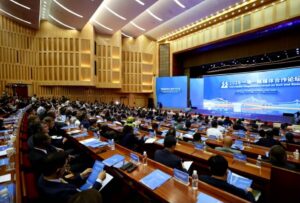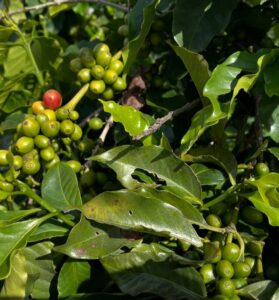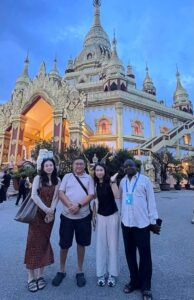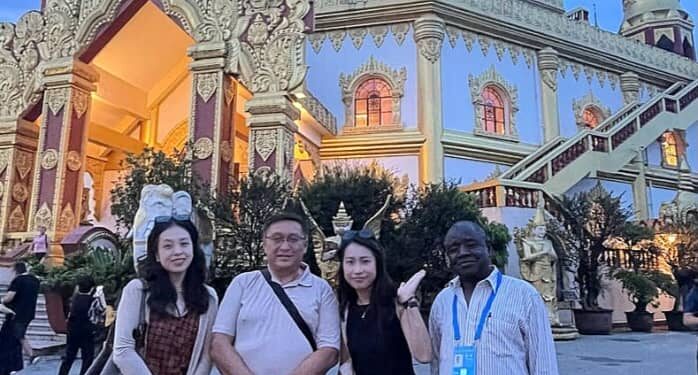EXPLORING CHINA’S YUNNAN AND ITS COFFEE HAVEN : Travelogue
By Lawal Sale
When I received the invitation to come to Kunming city of Yunnan province in South Western China for the 2025 Media Cooperation Forum on Belt and Road and Silk Road Global News Award, I never imagined that it would be a remarkable opportunity for me to explore most of the south-western part of China bordering Laos, Vietnam and Myanmar.
The host, the province and the city :
The programme was organised by People’s Daily of China, the largest and most influential Newspaper in China, which was also ranked among the top 10 newspapers in the world in 1992 by the UNESCO.
The two events in Kunming were supported with site visits to some cities, towns and villages across the province.
The site visits, specially organised and designed for award recipients of the Silk Road Global News Award (this writer inclusive), saw the 19 delegates from Russia, Pakistan, Malaysia, Hungary, Kazakhstan, Armenia, Turkey, Kyrgyzstan, Egypt, Uganda and Nigeria visiting unique sites, meeting with the good people of Yunnan, while consuming its cuisines and coffee. Everything was in abundance.
Yunnan province, like any other province in China, has its unique identity — it is a gateway connecting China to Southeast Asia and South Asia; and a vital hub for ancient Silk Road and Belt and Road Initiative.
The region is also known for its unique floral and coffee varieties.
The region is so diverse — it is one of the provinces with the highest number of ethnic groups and it is home to 25 ethnic groups.
The sprawling city of Kunming is the headquarters of this unique province of wonders.
As the host city of the two events, the organisers certainly made a wise decision to choose this warm city of flowers for the gathering of top Chinese government officials and hundreds of media executives from all over the world.
The schedule in Kunming was tight. Therefore, the delegates virtually had no time to explore the city, as we were always engaged in different panel discussions.
In spite of the tight schedule, I sneaked out one evening, jumped on a bus and headed for the city centre to see things for myself. It was a superlative experience.

Although Kunming was not bustling like Beijing, Shanghai or Chongqing, the city was warm, serene and sparkling, with clean streets adorned with flowers and friendly people.
In my street-by-street walk, I didn’t miss some bowls of hot noodles garnished with minced beef, soy sauce, vinegar and chilli paste and green onions.
The brief solo outing was an awesome experience. I must say!!
Kunming city also hosts the railway artery connecting China with landlocked Southeastern and Southern Asian countries.
The landmark 1,055 km-long China-Laos railway, which was jointly built by China and Laos, was launched three years ago.
The high-speed rail line has been making significant impact on the lives of the residents of the region; cutting travel time and making the movement of passengers and goods stress-free.
The railway is regarded as symbol of Belt and Road cooperation and a starting point for connectivity to the rest of Southeastern and Southern Asian countries.
The Media Tour, Research and Activities:
Immediately after the forum and award ceremony in Kunming, the organizers sprang into action to ensure that the delegates enjoyed every minute and every hour of the visit.
The delegates departed Kunming four days after the events in the city and headed for what one of the co-awardees described as the onset of “check-in, check-out” movements (based on the guidebook of tour given to us).
The description was quite apt as it was the beginning of the visits to “sites”, for we embarked on a city-to-city tour, spending a night in a city or town and then, moving to another neighbourhood the next day.
In the course of our movements, I am bold to say that in all of my trips to China, I have never seen huge mountains with tunnels stretching several kilometers, akin to what I saw in Yunnan province.
Yunnan is indeed unique in all aspects – the people, the cuisine,the coffee, the flowers,the mountains, the rivers,the canals and the pagodas.

During our voyage, we crisscrossed well-tarred roads, meandered in between mountains and endured the turbulence in the clouds to reach cities, towns and villages of Baoshan, Xinzhai, Menghe, Heshun, Simola wa, Tenchong and Mangshi Dehong.
The experience was by all means spectacular and memorable.
Anywhere we visited, there was something spectacular in the area to remember for a long time.
Yunnan as Coffee Haven of China:
The first city to visit after Kunming was Baoshan city.
Baoshan is a beautiful and serene city renowned for growing Arabica coffee beans of high quality.
Until then, I was never aware of the fact China produces one of the best Arabica coffee beans; and from what I have seen and heard, very soon, the world’s second largest economy will be among the major world coffee growers like Brazil, Ethiopia, Columbia, Uganda and Vietnam.
After sampling this brand of coffee in one of the coffee estates in Baoshan, I found that the coffee grown in Yunnan province is full of beans, with rich aroma and smooth acidity, while leaving lasting taste in the mouth.
I am a coffee lover; so, I am talking from experience.
Still in Baoshan, we were taken for a guided tour of a prominent coffee estate called Beaton Gaoligong Boutique Coffee Estate to explore the facility and have a sip of its brand of coffee.
Baoshan Arabica coffee, we were told, is of the best quality and it has received a lot of commendations from domestic and international coffee experts and consumers. It has, over the years, won many international awards for its products.
From Baoshan, the Silk Road Global News Awardees, the staff/coordinators from the People’s Daily and media crew from various outlets in Yunnan continued with the mission of exploring China’s coffee industry and moved to Xinzhai village in Lujiangba in Longyang District of Baoshan.

In the village, we were warmly received by the villagers and coffee farmers atop a mountain towering over 900 metres above the sea level.
In fact, I was quite amazed that a big bus could climb such a height but the road to the mountain crest was tarred with safety rails in place.
The mountain crest is the most suitable place for cultivating coffee, according to one of the villagers.
As usual, the moment we disembarked from our buses, we were welcomed with hot or cold coffee, depending on an individual’s choice.
After the sip of the aromatic beverage, the owner of the coffee farm, Mr. He Weijun, took us round his farm for a tour.
In my personal interaction with him, he disclosed that his modest farm produced more than 30 metric tonnes of coffee currently and was expected to produce up to 100 metric tonnes in the next three years.
He said that the maturity period for coffee is three years, while its harvest season is between April and November.
Weinjun said that Xinzhai village was reputed for producing high-quality coffee, with over 70 years of coffee cultivation history.
Although local producers are not able to meet the demand of domestic consumers, the increasing cultivation of coffee in Yunnan province is significantly reducing China’s dependency on imported product.
Besides, Weinjun said that major local and foreign coffee chains in China like Luckin coffee and Starbucks often patronised coffee produced by local farmers from Yunnan province.
Yunnan province is China’s coffee haven, producing about 98 per cent of total national coffee output with production volumes totalling more than 146,000 metric tonnes.
Tour of Golden and Silver Pagoda:
Away from coffee farms and estates, while in Mangshi, the organisers decided that we should visit some landmarks of Yunnan to see the historical and tourism sites of the province.
We were taken on a tour of the twin Buddhist pagodas atop Leiya Rang Mountain beside Peacock Lake in Mangshi.
The site is a unique tourist attraction among the Pagodas and temples in the area.
Two giant Pagodas caught our attention, as the bus ferrying us was climbing to the site atop the mountain.
We were told by the tour guide that there were two Pagodas and other Buddhist relics on the mountain.
The most prominent are the Grand Golden Pagoda and Silver Pagoda. The existence of the Pagodas dated back to the Qing dynasty.
According to the guide, the original Golden Pagoda was built 1803 but was destroyed during wars.
The 76-metre high Pagoda was reconstructed in 2004; it was made of steel and covered with gold foil, using 1.3 tonnes of gold.
The Pagoda is an important religious site for the Dai people in Mangshi.
Similarly, Silver Pagoda is situated on top of the same Leiya Rang Mountain in Mangshi.
Its height is 66 metres, while its diameter is 46 meters. Silver Pagoda is stunning and beautiful.
Brief stay in Shanghai:
From Mangshi Dehong, the delegates were flown to Shanghai to continue with our research activities and visits to places of interest.
In Shanghai, we concluded our mission and thereafter departed to our various countries.
*Sale is Global South Affairs Analyst and a recipient of 2025 Silk Road Global News Award (lawalmaida1@yahoo.com)*
(vitalnewsngr.com)























